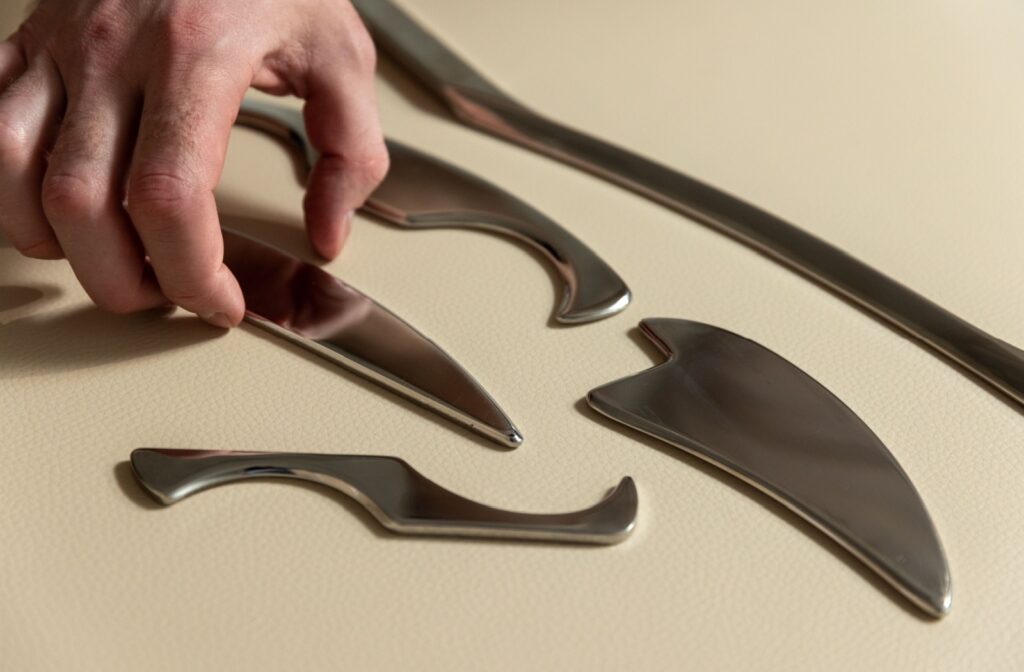If you’ve been dealing with chronic pain, muscle tension, or sports injuries that won’t seem to heal, you’ve probably explored various treatment options. Physical therapy, traditional massage, stretching routines—maybe you’ve tried them all.
A Graston massage is a unique approach to treating soft tissue injuries and chronic pain conditions, as it differs from traditional massage, which relies solely on hands. The Graston Technique utilizes specially designed stainless steel instruments to detect and treat areas of scar tissue and fascial restrictions.
Whether you’re an athlete looking to enhance performance, someone recovering from an injury, or dealing with persistent musculoskeletal issues, the Graston Technique could be the solution you’ve been looking for.
How the Graston Technique Works
The Graston Technique operates on a straightforward yet scientifically backed principle: targeted mechanical stimulation of soft tissues can promote healing and restore normal function.
During treatment, specially-trained practitioners apply the instruments to your skin using controlled pressure and specific stroke patterns. These tools act as an extension of the therapist’s hands, allowing them to detect tissue irregularities that might be missed during a standard examination.
The technique works through several mechanisms. First, it breaks down scar tissue and fascial restrictions that can limit the range of motion and cause pain. Second, it increases blood flow to the treated area, delivering oxygen and nutrients essential for healing. Third, it stimulates the production of new collagen, which helps rebuild healthy tissue structure.
Conditions Treated by a Graston Massage
The versatility of the Graston Technique makes it an effective treatment for a wide range of musculoskeletal conditions. Many practitioners use it as part of a comprehensive treatment plan for both acute injuries and chronic conditions.
Sports & Overuse Injuries
Tennis elbow, golfer’s elbow, runner’s knee, and Achilles tendinitis are among the commonly treated conditions. The technique’s ability to break down scar tissue makes it particularly valuable for athletes dealing with repetitive strain injuries.
Post-Surgical Rehabilitation
Following procedures like knee surgery, rotator cuff repair, or carpal tunnel release, scar tissue formation is inevitable. The Graston Technique can help minimize excessive scarring and restore normal tissue mobility during the recovery process.
Chronic Pain Conditions
Chronic pain conditions such as plantar fasciitis, IT band syndrome, and chronic neck pain have shown positive responses to Graston treatment. These conditions often involve fascial restrictions and tissue adhesions that traditional treatments struggle to address effectively.
Workplace Injuries
Workplace injuries, such as carpal tunnel syndrome, trigger finger, and various repetitive strain injuries, may also benefit from this approach. Office workers, manual labourers, and anyone whose job involves repetitive motions can develop the types of soft tissue restrictions that the Graston Technique specifically targets.

What to Expect During a Graston Session
Your first Graston session will typically begin with a thorough evaluation. The practitioner will assess your movement patterns, identify areas of restriction, and discuss your symptoms and treatment goals. This evaluation helps identify areas that require attention and guides the treatment approach.
Before applying the instruments, the practitioner typically performs some manual therapy or gentle stretching to prepare the tissues. A small amount of lotion or cream is applied to the treatment area to allow the instruments to glide smoothly across your skin.
The actual instrument application involves systematic scanning of the affected area. The practitioner uses different tools and stroke patterns, applying controlled pressure to detect and treat tissue irregularities. You might hear scraping sounds as the instruments work across your skin. This is entirely normal and indicates that the tools are effectively addressing tissue restrictions.
Benefits of the Graston Technique
The documented benefits of the Graston Technique extend beyond simple pain relief. Many patients experience improved range of motion within just a few sessions, as the technique effectively addresses the fascial restrictions that limit joint mobility. Other benefits include:
- Pain reduction: Many people report significant improvement in pain levels after completing a course of treatment
- Faster healing: The increased blood flow and controlled inflammatory response promoted by Graston treatment can accelerate your body’s natural healing processes
- Enhanced athletic performance: By improving tissue quality and joint mobility, the Graston Technique can help athletes move more efficiently and reduce their risk of future injuries
- Long-lasting results: Unlike some treatments that provide only temporary relief, addressing the underlying tissue restrictions can lead to sustained improvement
- Noninvasive nature: While some temporary side effects like mild bruising or soreness are possible, serious complications are rare when properly trained practitioners perform the technique
Is Graston Technique Right for You?
Determining whether the Graston Technique is suitable for your specific situation requires careful consideration of several factors. The technique is most effective for conditions involving soft tissue restrictions, scar tissue formation, or fascial adhesions.
Finding a Graston Practitioner
Locating a qualified Graston practitioner requires some research, as not all manual therapists are trained in this specific technique.
Proper certification is crucial. Legitimate Graston practitioners must complete specific training courses and maintain their certification through continuing education. Don’t hesitate to ask about a practitioner’s training and experience with the technique.
Ask questions during your initial consultation. Inquire about the practitioner’s experience treating your specific condition, their typical treatment protocols, and what results you might reasonably expect. A qualified practitioner should be able to explain the technique clearly and address any concerns you may have.
Taking the Next Step Toward Recovery
The Graston Technique offers a unique approach to treating soft tissue dysfunction and chronic pain conditions. By utilizing specialized instruments to address scar tissue, fascial restrictions, and muscle tension, this technique can provide relief when other treatments have been ineffective.
If you’re considering a Graston massage, start by consulting with a qualified practitioner who can evaluate your specific situation and determine whether this approach aligns with your treatment goals. Contact our team at Recovery Lab in Red Deer to discuss your massage therapy options. We can help you determine if a Graston massage is right for you.



